Plasmon-Induced Flexibility and Refractive Index Measurement in A Sensor Designed by a Cavity, Two Rings, Two Teeth and Two Plasmonic Waveguides
Article Information
Hamid Abbasi*
University of Mazandaran, Iran.
*Corresponding Author: Hamid Abbasi, University of Mazandaran, Iran.
Received: 27 September 2023; Accepted: 18 October 2023; Published: 30 October 2023.
Citation: Hamid Abbasi. Plasmon-Induced Flexibility and Refractive Index Measurement in A Sensor Designed by a Cavity, Two Rings, Two Teeth and Two Plasmonic Waveguides. Journal of Analytical Techniques and Research 5 (2023): 16-20.
Share at FacebookAbstract
In this research, we design a plasmonic refractive index sensor and examine it numerically, using transparency, refractive index, sensitivity, FOM fit shape and Q quality factor, to optimize and improve performance quality. We will be. To design the structure of this sensor, we use two plasmonic waveguides, a cavity, two rings and two teeth. The resonant wavelengths and refractive index of the resonators are investigated and simulated by the finite difference time domain (FDTD) method, and we draw the obtained diagrams using MATLAB software. After completing the sensor design, due to the fact that the amplifiers are very sensitive to changes in the refractive index, so by changing the refractive index and changing the dimensions of the structure, we can weaken or strengthen the passage coefficient in the resonant modes. These plasmonic sensors with a simple frame and high optical resolution can be used to measure refractive index in the medical, chemical and food industries.
Keywords
Photonic, Plasmonic, Surface Plasmons, Waveguide, Resonators, Optic.
Photonic articles; Plasmonic articles; Surface Plasmons articles; Waveguide articles; Resonators articles; Optic articles.
Photonic articles Photonic Research articles Photonic review articles Photonic PubMed articles Photonic PubMed Central articles Photonic 2023 articles Photonic 2024 articles Photonic Scopus articles Photonic impact factor journals Photonic Scopus journals Photonic PubMed journals Photonic medical journals Photonic free journals Photonic best journals Photonic top journals Photonic free medical journals Photonic famous journals Photonic Google Scholar indexed journals Plasmonic articles Plasmonic Research articles Plasmonic review articles Plasmonic PubMed articles Plasmonic PubMed Central articles Plasmonic 2023 articles Plasmonic 2024 articles Plasmonic Scopus articles Plasmonic impact factor journals Plasmonic Scopus journals Plasmonic PubMed journals Plasmonic medical journals Plasmonic free journals Plasmonic best journals Plasmonic top journals Plasmonic free medical journals Plasmonic famous journals Plasmonic Google Scholar indexed journals Surface Plasmons articles Surface Plasmons Research articles Surface Plasmons review articles Surface Plasmons PubMed articles Surface Plasmons PubMed Central articles Surface Plasmons 2023 articles Surface Plasmons 2024 articles Surface Plasmons Scopus articles Surface Plasmons impact factor journals Surface Plasmons Scopus journals Surface Plasmons PubMed journals Surface Plasmons medical journals Surface Plasmons free journals Surface Plasmons best journals Surface Plasmons top journals Surface Plasmons free medical journals Surface Plasmons famous journals Surface Plasmons Google Scholar indexed journals Waveguide articles Waveguide Research articles Waveguide review articles Waveguide PubMed articles Waveguide PubMed Central articles Waveguide 2023 articles Waveguide 2024 articles Waveguide Scopus articles Waveguide impact factor journals Waveguide Scopus journals Waveguide PubMed journals Waveguide medical journals Waveguide free journals Waveguide best journals Waveguide top journals Waveguide free medical journals Waveguide famous journals Waveguide Google Scholar indexed journals Resonators articles Resonators Research articles Resonators review articles Resonators PubMed articles Resonators PubMed Central articles Resonators 2023 articles Resonators 2024 articles Resonators Scopus articles Resonators impact factor journals Resonators Scopus journals Resonators PubMed journals Resonators medical journals Resonators free journals Resonators best journals Resonators top journals Resonators free medical journals Resonators famous journals Resonators Google Scholar indexed journals Optic articles Optic Research articles Optic review articles Optic PubMed articles Optic PubMed Central articles Optic 2023 articles Optic 2024 articles Optic Scopus articles Optic impact factor journals Optic Scopus journals Optic PubMed journals Optic medical journals Optic free journals Optic best journals Optic top journals Optic free medical journals Optic famous journals Optic Google Scholar indexed journals plasmonic waveguides articles plasmonic waveguides Research articles plasmonic waveguides review articles plasmonic waveguides PubMed articles plasmonic waveguides PubMed Central articles plasmonic waveguides 2023 articles plasmonic waveguides 2024 articles plasmonic waveguides Scopus articles plasmonic waveguides impact factor journals plasmonic waveguides Scopus journals plasmonic waveguides PubMed journals plasmonic waveguides medical journals plasmonic waveguides free journals plasmonic waveguides best journals plasmonic waveguides top journals plasmonic waveguides free medical journals plasmonic waveguides famous journals plasmonic waveguides Google Scholar indexed journals nanoscale dimensions articles nanoscale dimensions Research articles nanoscale dimensions review articles nanoscale dimensions PubMed articles nanoscale dimensions PubMed Central articles nanoscale dimensions 2023 articles nanoscale dimensions 2024 articles nanoscale dimensions Scopus articles nanoscale dimensions impact factor journals nanoscale dimensions Scopus journals nanoscale dimensions PubMed journals nanoscale dimensions medical journals nanoscale dimensions free journals nanoscale dimensions best journals nanoscale dimensions top journals nanoscale dimensions free medical journals nanoscale dimensions famous journals nanoscale dimensions Google Scholar indexed journals plasmonic devices articles plasmonic devices Research articles plasmonic devices review articles plasmonic devices PubMed articles plasmonic devices PubMed Central articles plasmonic devices 2023 articles plasmonic devices 2024 articles plasmonic devices Scopus articles plasmonic devices impact factor journals plasmonic devices Scopus journals plasmonic devices PubMed journals plasmonic devices medical journals plasmonic devices free journals plasmonic devices best journals plasmonic devices top journals plasmonic devices free medical journals plasmonic devices famous journals plasmonic devices Google Scholar indexed journals nanometers articles nanometers Research articles nanometers review articles nanometers PubMed articles nanometers PubMed Central articles nanometers 2023 articles nanometers 2024 articles nanometers Scopus articles nanometers impact factor journals nanometers Scopus journals nanometers PubMed journals nanometers medical journals nanometers free journals nanometers best journals nanometers top journals nanometers free medical journals nanometers famous journals nanometers Google Scholar indexed journals
Article Details
1. Introduction:
Surface plasmon polaritons (SPPs) have been studied extensively recently due to the fact that they confine light at nanoscale dimensions [1]. As a result of these unique features, SPPs are used in many structures such as filters [2], optical demultiplexers, bio-sensors [3-36], logic gates and etc. The metal–insulator-metal (MIM) optical waveguide is used extensively for design of many plasmonic devices due to its ability to confine light within a small area and its compatibility with electronic platforms [37-46]. In addition, having a simple design procedure makes it one of the most favorable structures. Consequently, a diversity of MIM plasmonic devices have been designed and implemented. Some of them are optical filters, sensors, coulpers, slow light devices, splitters and all-optical switches. A good refractive index sensor needs to have a good sensitivity (S) and a high figure of merit (FOM). Increasing the device size usually increases the sensitivity, but larger structures have higher full width half maximum, which leads to a reduction of FOM. Many criteria can be used to implement refractive index sensors, but plasmonic sensors are more suitable for integrated circuits due to their very small size (nanometers). Recently, various types of plasmonic sensors have been designed and manufactured. Among them, plasmonic refractive index sensors require high sensitivity and resolution. Conventional plasmonic sensors consist of a MIM waveguide with a cavity. Such cavities can have a variety of geometries such as tooth-shaped, disc-shaped, ring-shaped, and so on. In this paper, we propose a MIM plasmonic sensor with two rings and a cavity and two teeth. To simulate the sensor, the two-dimensional finite difference time domain (FDTD) method with a uniform mesh size of 8 nm has been used. The boundary condition for all directions is selected as the perfectly matched layer (PML).
2. Structural model and theory analysis
There are many structures for designing optical sensors. These optical sensors usually include amplifiers and waveguides. Each waveguide with any geometric shape has the ability to transmit waves and can limit their energy in one and two dimensions. The proposed structure is shown in Figure 1, which includes two waveguides and a cavity, and two rings and two teeth. The input wave goes from the left waveguide to the structure and after passing through them goes to the output waveguide. The width of the two waveguides is w1 = 50 nm. The middle ring is located in the middle of two waveguides that have an inner radius of r1 = 90 nm and an outer radius of R1 = 133 nm, which is located at a distance of 19 nm from the two waveguides. The two teeth are connected to the middle ring, which has a length of 40 nm and a height of 20 nm. A ring is located at the bottom of the right waveguide and has an inner radius of r1 = 91 nm and an outer radius of R1 = 126 nm. The cavity also has a length of L = 80 nm and a height of W2 = 200 nm. The lower ring is attached to the waveguide and the cavity and the distance from the cavity to the waveguide is 55 nm. Pin and Pout are the monitors for measuring the input and output waves, respectively, and the transmission is calculated by T = Pout / Pin.
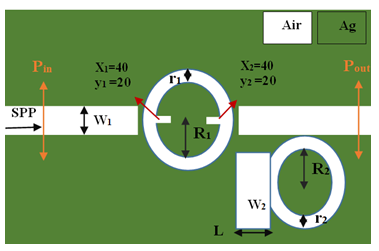
Figure 1: Two-dimensional image of a plasmonic sensor
As shown in the 2D image, the green and white areas represent silver and air, respectively. The air permittivity is set to ε = 1 and the silver permittivity is used using the greeting model as follows:

Here c∞ gives the medium constant for the infinite frequency, ωp refers to bulk frequency for plasma, γ means damping frequency for electron oscillation, and ω shows incident light angular frequency. The parameters for silver are c∞ = 1, ωp =1.37 × 1016 Hz, and γ = 3.21 × 1013 Hz. Only TM mode is available in the structure. According to Figure 1, the TM wave, which is used for SPP excited waves, starts propagating from the left waveguide and propagates in the waveguide, and its intensity decreases as it gets closer to the output port. After distributing the field at the resonant frequency of the simulated structure, each amplifier reflects a certain amount of input wave.
3. Fracture coefficient simulation and measurement methods
The resonant behavior of the proposed structure is examined numerically and theoretically. In the numerical approach, we use the time domain finite difference (FDTD) simulation method with perfectly matched layer boundary conditions (PML) because this method effectively reduces the numerical reflection. The uniform mesh size is 8 nm. First, to measure the performance of the sensor and increase its quality, we must change its refractive index. This is done in the wavelength range of 400 to 1500 nm and the refractive index of the middle ring will change in steps of 0.01 from 1.15 to 1.2 nm. An electromagnetic field is generated by the excitation of a sensing element using light generated by SP that is concentrated on the metal surface. The refractive index of the MIM changes when the material under contact contacts the sensor. SPs are very sensitive to changes in refractive index in the vicinity of the surface. The reason we have only changed the refractive index of one ring and the refractive index of other amplifiers remains the same is to achieve a better result and a stronger sensor design. The transmission spectrum from the sensor device is shown in Figure 2.
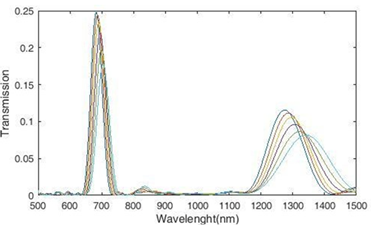
Figure 2: Transmission spectra of plasmonic refractive index sensor
After comparing the wavelengths using the refractive index change and plotting the transmission spectrum, we must obtain the three criteria of sensitivity S and the shape of the FOM and the quality factor Q. With this, we create a technology map to define the standard and development process of optical refractive index sensors. Sensitivity S defines the ratio of the output wavelength change of the sensor to the refractive index changes and is obtained from the following relation:
S = Δ λ / Δn (nm / RIU) (2)
We see the diagram of the plasmonic sensitivity coefficient in Figure 3, which according to the figure, has the highest sensitivity for the refractive index n = 1.2 (in mode2) which is equal to 2359 nm / RIU and the lowest value for the refractive index n = 1.16 (in mode1) Which is equal to 314.1 nm / RIU.
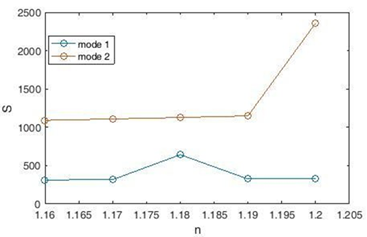
Figure 3: Plasmonic sensor sensitivity coefficient diagram Resonance wavelength versus refractive index analysis.
The next item is the figure of merit (FOM), which determines the sensitivity of the SRI to the resonance width curve (FWHM) and how accurately the minimum resonance can be measured. FOM is calculated as follows:
FOM = SRI / FWHM (3)
We see the diagram of the figure of merit (FOM) in Figure 4, which according to the figure has the highest value for the refractive index n = 1.18 (in mode1) which is equal to 15.03 and the lowest value for the refractive index n = 1.12 (in mode1) which is equal to With 7.354.
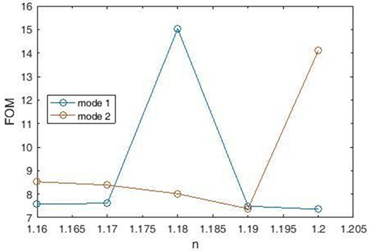
Figure 4: Plasmonic sensor FOM diagram.
And the last case is the quality factor Q, which is obtained from the following equation:
Q = λres / FWHM (4)
We see the quality factor Q diagram in Figure 5.
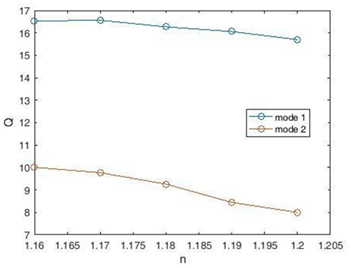
Figure 5: Quality factor diagram of Q plasmonic sensor.
According to the figure, the highest value of quality factor Q is for refractive index n = 1.17 (in mode1) which is equal to 16.56 and the lowest value for refractive index is n = 1.19 (in mode2) which is equal to 7.379. These three factors (S and FOM sensitivity and Q quality factor) and their numerical values showed that this sensor has good performance and quality and has a higher sensitivity compared to similar articles.
Conclusion:
In this paper, a very high resolution refractive index optical sensor is presented. It is based on plasmonic conductors of metal-metal insulation. The structure is numerically simulated using the finite difference time domain method. The proposed structure is thought to consist of two plasmonic waveguides, a cavity, two rings and two teeth. This sensor provides a sensitivity of 2359 nm / RIU and a maximum rating of 15.0316 RIU-1 (FOM). Due to its high resolution resolution, this sensor can easily change 0.01% in the analytic refractive index for the index in the range of 1.15-1.2.
Competing Interest:
The authors declare no conflicts of interest.
References
- Ebbesen, Thomas W, A Dereux, et al. Surface plasmon subwavelength optics. Nature 424 (2003): 824-830.
- Wu W. Ultra-high resolution filter and optical field modulator based on a surface plasmon polariton. Optics Letters 41 (2016): 2310.
- Chen L. Numerical analysis of a near-infrared plasmonic refractive index sensor with high figure of merit based on a fillet cavity. Optics Express 24 (2016): 9975.
- Tong L. Recent advances in plasmonic sensors. Sensors 14 (2014): 7959.
- Y Shen, JH Zhou, TR Liu, et al, Plasmonic gold mushroom arrays with refractive index sensing figures of merit approaching the theoretical limit. Nat. Commun 4 (2013): 2381.
- Srivastava, Triranjita, R Das, et al. Highly Sensitive Plasmonic Temperature Sensor Based on Photonic Crystal Surface Plasmon Waveguide. Plasmonics 8 (2013): 515-521.
- Maisonneuve M. Phase sensitive sensor on plasmonic nanograting structures. Optics Express 19 (2011): 26318-26324.
- Elsayed, Mohamed Y, Y Ismail, et al. Semiconductor plasmonic gas sensor using on-chip infrared spectroscopy. Applied Physics 123 (2017): 113.
- Cen C, Lin H, Huang J, et al. A Tunable Plasmonic Refractive Index Sensor with Nanoring-Strip Graphene Arrays. Sensors 18 (2018): 4489.
- Cheng F, Yang X, Gao J. Enhancing intensity and refractive index sensing capability with infrared plasmonic perfect absorbers. Opt Lett 39 (2014): 3185-3188.
- Cheng L, Wang Z, He X, et al. Plasmonic nanosensor based on multiple independently tunable Fano resonances. Beilstein J Nanotechnol 10 (2019): 2527-2537.
- Chou Chao CT, Chou Chau YF, Huang HJ, et al. Highly Sensitive and Tunable Plasmonic Sensor Based on a Nanoring Resonator with Silver Nanorods. Nanomaterials (Basel) 10 (2020): 1399.
- Di Wu, Jinping Tian, Lu Li, et al. Plasmon induced transparency and refractive index sensing in a new type of graphene-based plasmonic waveguide. Optics Communications (2018).
- Haque, S Mahmuda, MA Hossain, et al. "Highly Sensitive Dual-Core PCF Based Plasmonic Refractive Index Sensor for Low Refractive Index Detection," in IEEE Photonics Journal 11 (2019): 1-10.
- El Shamy RS, Khalil D, Swillam MA. Mid Infrared Optical Gas Sensor Using Plasmonic Mach-Zehnder Interferometer. Sci Rep 10 (2020): 1293.
- 168-Esfahani Monfared Y. Overview of Recent Advances in the Design of Plasmonic Fiber-Optic Biosensors. Biosensors 10 (2020): 77.
- Gryga M, Ciprian D, Hlubina P. Bloch Surface Wave Resonance Based Sensors as an Alternative to Surface Plasmon Resonance Sensors. Sensors 20 (2020): 5119.
- ghiasi M, Mehrzad H, Mohajerani E. Sensor based on plasmonic absorption of island metal films, varying refractive index of the surrounding environment (2017).
- Gomez-Cardona N, Reyes-Vera E, Torres P. High Sensitivity Refractive Index Sensor Based on the Excitation of Long-Range Surface Plasmon Polaritons in H-Shaped Optical Fiber. Sensors 20 (2020): 2111.
- Kanso M, Cuenot S and Louarn G. Sensitivity of Optical Fiber Sensor Based on Surface Plasmon Resonance: Modeling and Experiments. Plasmonics 3 (2008): 49-57.
- MA Butt, SN Khonina and NL Kazanskiy. "Plasmonic refractive index sensor based on M-I-M square ring resonator," International Conference on Computing, Electronic and Electrical Engineering (ICE Cube) (2018).
- Mayer KM and Hafner JH. Localized surface plasmon resonance sensors. Chemical reviews 6 (2011): 3828-3857.
- Mohammad Reza Rakhshani. Wide-angle perfect absorber using a 3D nanorod metasurface as a plasmonic sensor for detecting cancerous cells and its tuning with a graphene layer.Photonics and Nanostructures -Fundamentals and Applications.photonics 30 (2022): 10387-10399.
- Zhang Z, Yang J, He X, et al. Plasmonic Refractive Index Sensor with High Figure of Merit Based on Concentric-Rings Resonator. Sensors 18 (2018): 116.
- Nguyen HH, Park J, Kang S, et al. Surface plasmon resonance: a versatile technique for biosensor applications. Sensors 15 (2015): 10481-10510.
- Rabiul Al Mahmud, Md Omar Faruque, Rakibul Hasan Sagor. A highly sensitive plasmonic refractive index sensor based on triangular resonator.Optics Communications 483 (2021): 126634.
- Rahmatiyar M, Danaie M and Afsahi M. Employment of cascaded coupled resonators for resolution enhancement in plasmonic refractive index sensors. Opt Quant Electron 52 (2020): 153.
- Rashed AR, Gudulluoglu B, Yun HW, et al. Highly- SensitiveRefractive Index Sensing by Near-infrared Metatronic Nanocircuits. Sci Rep 8 (2018).
- RM Piragash Kumar, A Venkatesh, VHS Moorthy. Nanopits based novel hybrid plasmonic nanosensor fabricated by a facile nanofabrication technique for biosensing, Materials Research Express 6 (2019): 1-19.
- Somayyeh Asgari, Siavash Pooretemad, Nosrat Granpayeh. Plasmonic refractive index sensor based on a double concentric square ring resonator and stub.Photonics and Nanostructures - Fundamentals and Applications 42 (2020): 100857.
- Takashima Y, Haraguchi M, Naoi Y. GaN-Based High-Contrast Grating for Refractive Index Sensor Operating Blue–Violet Wavelength Region. Sensors 20 (2020): 4444.
- Wang X, Wu X, Zhu J, et al. Theoretical Investigation of a Highly Sensitive Refractive- Index Sensor Based on TM0 Waveguide Mode Resonance Excited in an Asymmetric Metal-Cladding Dielectric Waveguide Structure. Sensors 19 (2019): 1187.
- Wenger Tobias, Viola Giovanni, Kinaret, et al. High-sensitivity plasmonic refractive index sensing using grapheme. 2D Materials 4 (2017).
- Xiling Shi, Lianjun Ma, Zhidong Zhang, et al. Dual Fano resonance control and refractive index sensors based on a plasmonic waveguide-coupled resonator system. Optics Communications 427 (2018): 326-330.
- Yang X, Hua E, Su H, et al. A Nanostructure with Defect Based on Fano Resonance for Application on Refractive-Index and Temperature Sensing. Sensors (Basel) 20 (2020):
- Yangyang Chen, Jinchuan Liu, Zhenchuan Yang, et al. (2019). Optical biosensors based on refractometric sensing schemes: A review, Biosensors and Bioelectronics 144 (2019): 111693.
- Maier, Stefan A. Plasmonics: Fundamentals and Applications. Springer Berlin 52 (2014): 49-74.
- Shu, Changgan. The sensing characteristics of plasmonic waveguide with a ring resonator. Optics Express 22 (2014): 7669-7677.
- Yan, Shu Bin. A Refractive Index Sensor Based on a Metal-Insulator-Metal Waveguide-Coupled Ring Resonator. Sensors 15 (2015): 29183-29191.
- Huang, Ye Xiong. A plasmonic refractive index sensor based on a MIM waveguide with a side-coupled nanodisk resonator. IEEE, International Conference on Embedded and Real-Time Computing Systems and Applications IEEE (2014): 1-5.
- Wu, Tiesheng. A nanometeric temperature sensor based on plasmonic waveguide with an ethanol-sealed rectangular cavity. Optics Communications 339 (2015): 1-6.
- Tang, Y. Refractive Index Sensor Based on Fano Resonances in Metal-Insulator-Metal Waveguides Coupled with Resonators. Sensors 17 (2017): 784.
- Zhang, Zhidong. Fano Resonance Based on Metal-Insulator-Metal Waveguide-Coupled Double Rectangular Cavities for Plasmonic Nanosensors. Sensors 16 (2016): 642.
- Zafar, Rukhsar, and M. Salim. Enhanced Figure of Merit in Fano Resonance-Based Plasmonic Refractive Index Sensor. IEEE Sensors Journal 15 (2015): 6313-6317.
- Zhao X, Z Zhang and S Yan. Tunable Fano Resonance in Asymmetric MIM Waveguide Structure. Sensors 17 (2017): 7.
- Chen, Jianjun. Coupled-Resonator-Induced Fano Resonances for Plasmonic Sensing with Ultra-High Figure of Merits. Plasmonics 8 (2013): 1627-1631.
